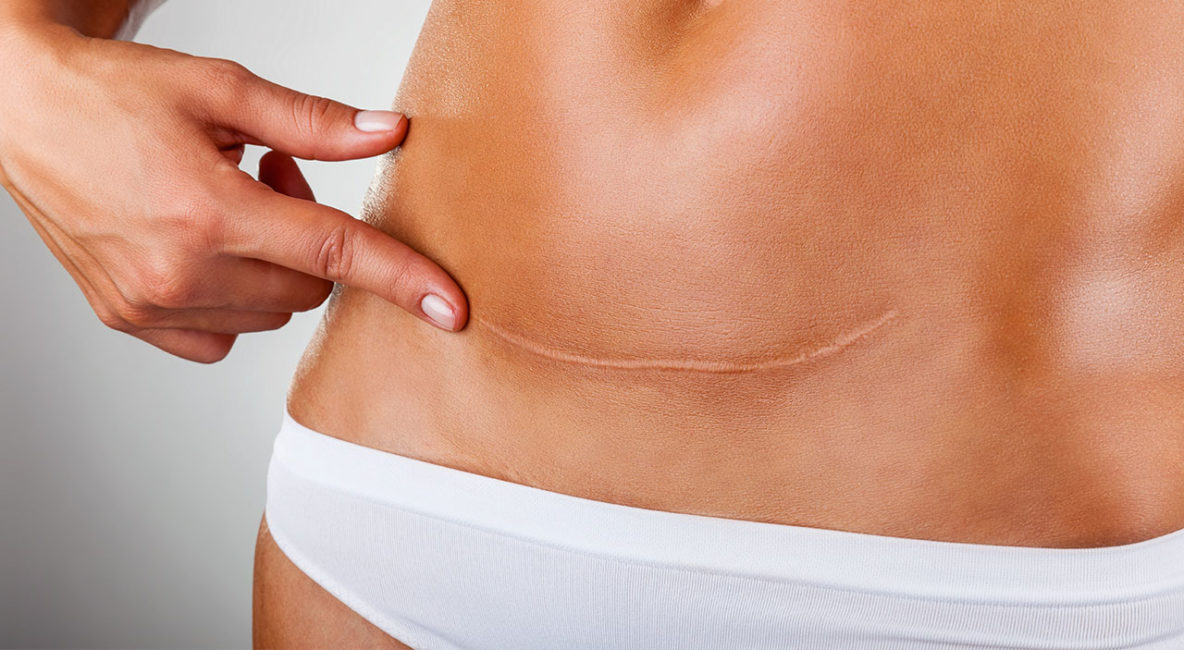Tummy tuck scars are inevitable, just like with every surgical operation. Patients should realistically expect to have a scar after surgery but also expect it to fade and “remodel” over the twelve month after the surgery. Although the surgery cannot be done without scars, the scars are planned to be as low on the abdomen as possible so as to be hidden by most clothing. However, excellent plastic surgeons will know based off of experience how to best address scarring. Scars can be raised or recessed, or distinguishable in color and texture from surrounding healthy skin. They can also be more apparent due to their size, shape, and/or location on the body.
While people who have undergone a tummy tuck may not have a hand in the operation itself, they can play a role in reducing the overall appearance of the the scars. But, following their surgeon’s post-operation directions to the proverbial “T”, is a must.
Types of tummy tuck scars
- Complete tummy tuck scars
- As the most common of the various tummy tuck scar types, it is defined by the longest incision made in any tummy tuck operation which is a somewhat horizontal line that spans across the lower abdomen from hip to hip.
- A second circular incision is cut around the navel (belly button).
- “Mini” tummy tuck
- While not scar-less, there is no navel (belly button) incision made and no subsequent scar in the area.
- However, there still is the lower abdominal incision which can vary in length and sometimes can be quite short.
Ways to treat tummy tuck scars
Patients need to be vigilant when monitoring themselves and their bodies after an abdominoplasty (tummy tuck). It is important to follow your surgeon’s post-operative instructions in regards to activity and cleansing. Despite best efforts sometimes issues can develop after surgery. Such things as a fever could indicate an infection. Patients can develop bleeding or wound healing issues which are complications that need to be found and addressed, should they arise. All these things can have an effect on the scars that form from the surgery.
Tummy tuck scarring timeline
Scars are typically most prominent within the first 3 months after surgery. Expect scars to look more reddish/purple and slightly raised in these first few months. Over time, the reddish/purple discoloration fades and the scar should flatten. This is a process that takes the body an average of 12 months to complete as long as there are no complications or hitches in the healing process. This timeline can also vary depending on color of the skin of the patient and their genetic background.
Tips and remedies for tummy tuck scarring
- Stay out of the sun – ultraviolet light exposure to scars can darken or change the final look of a scar
- Use sunblock even on scarred areas that are covered by clothing
- Listen to your doctor’s directions after the operations – they know your medical situation more intimately than anybody else
- Avoid smoking; nicotine directly inhibits the healing process of wounds and scars
- Applying such things as vitamin E, scar creams, baby oil, aloe vera or medical silicone creams topically may reduce the appearance of scars – consult your surgeon first before doing so
- Compression garments can alleviate tension on the incisions, reducing the appearance of scars
- Monitor your scars frequently – anything out of the ordinary may be a sign of a complication that may require closer evaluation
- Massaging scars can help the scars heal with the most aesthetic results
- Keep your spirits high. Some patients develop depression after surgery. TuckThatTummy is a wonderful online resource for anyone who may be coping with self-doubt
Scar revision surgery
If tummy tuck scars are still severe after an extended period of time and after trials of the above mentioned remedies, patients can elect to have them treated with additional medical procedures.
- Grafting involves removal of the scarred tissue and replacing it with skin cut away from another part of the patient’s body.
- Laser treatment targets damaged scar tissue with high-energy light. There may be multiple instances of treatment needed before the desired degree of scar removal or transformation is achieved.
- Scar revision/excision to remove the unsightly scar and re-closure of the skin edges
It’s a hard fact that scars simply cannot be entirely removed and surgery cannot be performed without the creation of some sort of scar. But with adherence to their doctor’s advice and consideration of all the options available, patients can have great results.

